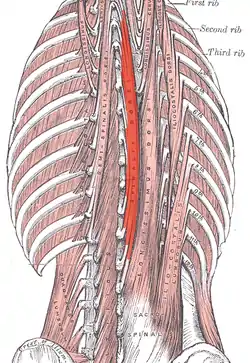Spinalis
The spinalis is a portion of the erector spinae, a bundle of muscles and tendons, located nearest to the spine. It is divided into three parts: Spinalis dorsi, spinalis cervicis, and spinalis capitis.
| Spinalis | |
|---|---|
 Deep muscles of the back (spinalis dorsi visible at center. Other spinalis muscles not visible). | |
| Details | |
| Origin | Thoracis: Spinous process of upper lumbar and lower thoracic vertebrae. Cervicis: nuchal ligament and spinous process of C7. |
| Insertion | Thoracis: Spinous process of upper thoracic vertebrae. Cervicis: Spinous process of cervical vertebrae except atlas. |
| Artery | Lateral sacral artery |
| Nerve | Posterior branch of spinal nerve |
| Actions | Laterally: Flex the head and neck to the same side. Bilaterally: Extend the vertebral column. |
| Antagonist | Rectus abdominis muscle |
| Identifiers | |
| Latin | Musculus spinalis |
| TA98 | A04.3.02.015 |
| TA2 | 2267 |
| FMA | 77179 |
| Anatomical terms of muscle | |
Spinalis dorsi
Spinalis dorsi, the medial continuation of the sacrospinalis, is scarcely separable as a distinct muscle. It is situated at the medial side of the longissimus dorsi, and is intimately blended with it; it arises by three or four tendons from the spinous processes of the first two lumbar and the last two thoracic vertebrae: these, uniting, form a small muscle which is inserted by separate tendons into the spinous processes of the upper thoracic vertebrae, the number varying from four to eight.
It is intimately united with the semispinalis dorsi, situated beneath it.
Spinalis cervicis
Spinalis cervicis, or spinalis colli, is an inconstant muscle, which arises from the lower part of the nuchal ligament, the spinous process of the seventh cervical, and sometimes from the spinous processes of the first and second thoracic vertebrae, and is inserted into the spinous process of the axis, and occasionally into the spinous processes of the two cervical vertebrae below it.
Spinalis capitis
Spinalis capitis (biventer cervicis) is usually inseparably connected with the semispinalis capitis.
Spinalis capitis is not well characterized in modern anatomy textbooks and atlases, and is often omitted from anatomical illustration. However, it can be identified as fibers that extend from the spinous processes of TV1 and CV7 to the cranium, often blending with semispinalis capitis
See also
References
![]() This article incorporates text in the public domain from page 399 of the 20th edition of Gray's Anatomy (1918)
This article incorporates text in the public domain from page 399 of the 20th edition of Gray's Anatomy (1918)
External links
- Anatomy figure: 01:06-04 at Human Anatomy Online, SUNY Downstate Medical Center - "Intrinsic muscles of the back."
- Dissection at ithaca.edu